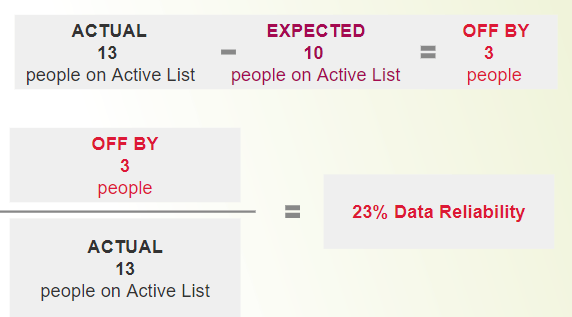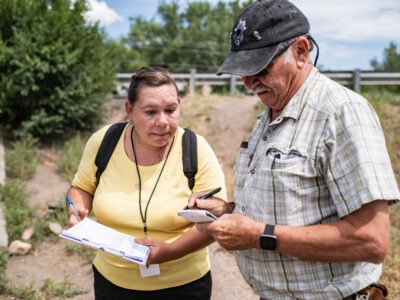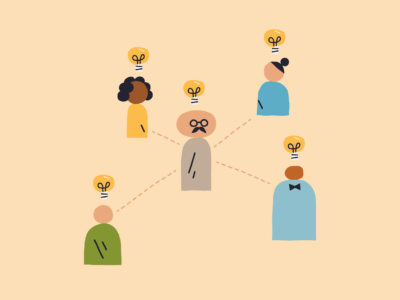Quality by-name data enables teams to account for every person experiencing homelessness in real time. Achieving it is a necessary step toward solving homelessness.
Communities in Built for Zero are committed to measurably and equitably ending homelessness for entire populations and proving it is possible. Communities are achieving and working toward functional zero — an ongoing state where homelessness is continuously rare and brief.
One of the most important solutions to ending homelessness begins with a new way of seeing it, known as a by-name list.
What is a by-name list?
By-name data (sometimes referred to as a by-name list) is a comprehensive data source of every person in a community experiencing homelessness, updated in real time. Using information collected and shared with their consent, each person on the list has a file that includes their name, homeless history, health, and housing needs. This data is updated monthly, at minimum.
How does by-name data help end homelessness?
By maintaining a by-name list, communities have current and detailed information on every unhoused person in a population. With this detailed information, they are able to better match housing solutions with the needs of the individuals. By-name lists often form the basis for case conferencing meetings, where all the providers within a community meet to coordinate and drive forward with housing solutions for people.
At the population level, communities are able to track the changing size, composition, and dynamics of their homeless population. This information enables them to prioritize resources, test changes to their system, and understand whether their efforts are helping to drive those numbers down toward zero.
What other insights are captured in by-name data?
By-name data helps communities understand the dynamics of homelessness at a population level.
They can answer important questions like: How many people became homeless for the first time this month? How many were people returning to homelessness? How many people exited from homelessness? Are the experiences of people moving through the system equitable?
Equipped with this data, communities can understand where to direct their attention and implement strategies that are as dynamic as the problem. They can also understand whether those strategies are driving numbers down, and if not, whether they need to pivot. Without this information, communities can get stuck in a cycle of solving yesterday’s problem, without knowing if they are moving any closer to the goal.
Specifically, communities can look at the following data points:
Inflow
When a person enters into homelessness, they’re part of what we call inflow. Inflow data captures people who are:
- Newly identified, or new to homelessness
- Returned from housing, or people who experienced homelessness before, got connected with housing, and now are homeless again
- Returned from Inactive, or people who experienced homelessness before and exited to unknown destinations (left town, were institutionalized for 90+ days etc), and now are homeless again
Actively homeless
People who are currently experiencing homelessness are categorized as being actively homeless.
Outflow
Outflow refers to people who have exited homelessness. This typically includes two groups:
- Housing placements, or people who have been connected to permanent housing
- Moved to inactive, or people who exit homelessness without support from the homeless response system, such as finding their own housing, moving out of the community, or entering a long-term stay in an institution
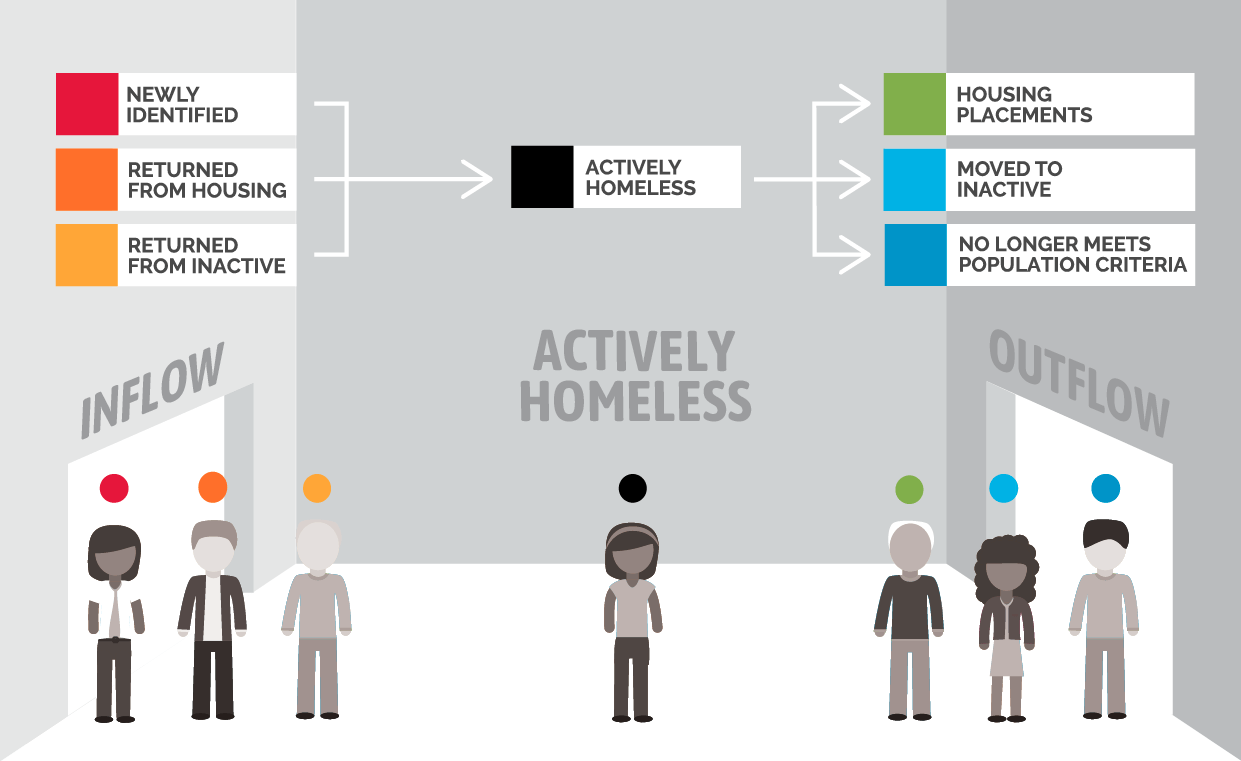
How is a by-name list different than the point-in-time count?
The U.S. Department of Housing and Urban Development (HUD) mandates an annual census of people experiencing homelessness, called the point-in-time count.
Historically, communities have relied heavily on point-in-time counts to understand whether the problem of homelessness is improving. They’ve used this number to develop local strategies and make budget decisions. But the count is just that — an estimate from a moment in time. There are no names behind it. No way to know what that number is today.
Using the point-in-time count is like taking a photo with an early model camera where the picture is distorted if the subject moves. Homelessness is always in flux, and the picture takes time to develop, in this case many months. The result is a hazy picture of the past.
Homelessness is a problem that changes every night. To keep up with it, we need a clear video. By-name lists is person-specific data, which is updated regularly, to provide communities with more actionable information on homelessness.
What is the difference between a by-name list and HMIS data?
A Homeless Management Information System (HMIS) is a database communities use to track how people experiencing homelessness interact with services. Communities incorporate this data into their by-name list.
By continually consolidating data from HMIS and local partners outside of the HUD-funded homeless-response system, plus constant outreach to individuals that might be disconnected from supportive services, communities have found it possible to identify everyone experiencing homelessness and support them from first contact all the way to achieving permanent stable housing. This continual, by-name approach gives all stakeholders a clear understanding of the community’s unique homelessness crisis in real time, allowing quicker case resolution for individuals and more efficient resource allocation across the community.
What about privacy?
In most communities, anyone on the by-name list will sign a consent form that stipulates who their data can be shared with. Community teams decide who this data will be shared with, and in most communities, this data is only used to help people connect with safe and stable long-term housing.
How do communities know they have achieved quality by-name data?
Built for Zero communities work with coaches to help them develop quality data on their local homeless population.
We provide a scorecard that uses qualitative and quantitative data to ensure that communities have covered their full jurisdiction and that all homeless service providers are coordinating their efforts.
The scorecard assesses:
- community participation and coverage, ensuring that a community is capturing all adults experiencing homelessness, including people living without shelter, people living in shelters, people living in transitional housing, people without homes about to enter hospitals or jails, and people fleeing domestic violence
- policies and procedures, ensuring that communities have policies in place to accurately reflect people entering or exiting homelessness and to maintain timely and accurate data
- data infrastructure to track data points related to system-wide inflow and outflow, and ensuring that the by name list has the capacity to track critical population-based statuses in real time, including age, household size, chronic homeless status, and veteran status
Some communities start by creating a by-name list focused on a specific population, like single adults. Others create lists that account for all households experiencing homelessness in their community. The goal is that eventually communities will build one list accounting for all people experiencing homelessness.
What about data reliability?
We use a concept called balanced data as a way to measure how reliable a community’s data is. Data is balanced if the change in the active homeless number from one month to the next is the same as the difference between inflow and outflow. In other words, it balances month over month, just like a checkbook!
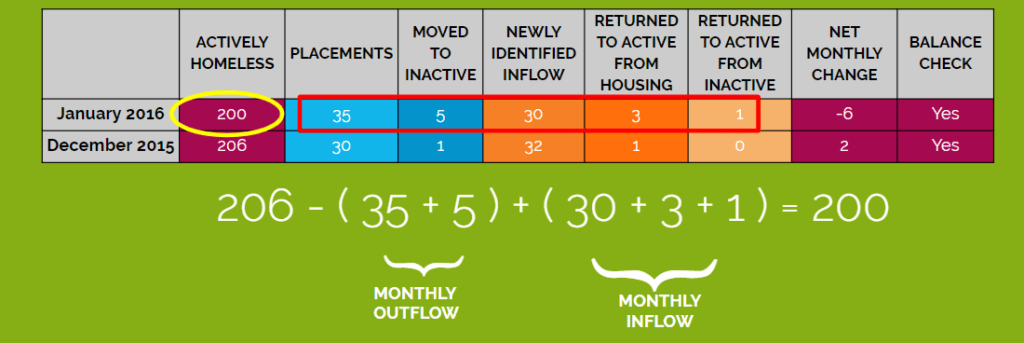
How do we calculate the data reliability percentage?
Data Reliability measures how far off data is from being balanced. To arrive at a Data Reliability Percentage, we determine how far off the ACTUAL number of people on our Active List is from the EXPECTED number of people on our Active List and look at the difference as a percentage of the number of people on our Active List.
